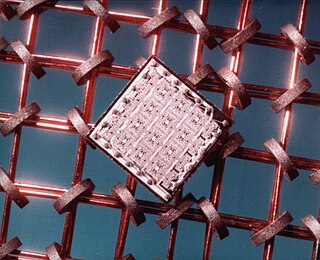
Computer memory stores information, such as data and programs, for immediate use in the computer. The term memory is often synonymous with the terms RAM,main memory, or primary storage. Archaic synonyms for main memory include core and store.

In computing, a hash table is a data structure that implements an associative array, also called a dictionary or simply map, which is an abstract data type that maps keys to values. A hash table uses a hash function to compute an index, also called a hash code, into an array of buckets or slots, from which the desired value can be found. During lookup, the key is hashed and the resulting hash indicates where the corresponding value is stored.

A microcontroller or microcontroller unit (MCU) is a small computer on a single integrated circuit. A microcontroller contains one or more CPUs along with memory and programmable input/output peripherals. Program memory in the form of NOR flash, OTP ROM, or ferroelectric RAM is also often included on the chip, as well as a small amount of RAM. Microcontrollers are designed for embedded applications, in contrast to the microprocessors used in personal computers or other general-purpose applications consisting of various discrete chips.
In computing, a core dump, memory dump, crash dump, storage dump, system dump, or ABEND dump consists of the recorded state of the working memory of a computer program at a specific time, generally when the program has crashed or otherwise terminated abnormally. In practice, other key pieces of program state are usually dumped at the same time, including the processor registers, which may include the program counter and stack pointer, memory management information, and other processor and operating system flags and information. A snapshot dump is a memory dump requested by the computer operator or by the running program, after which the program is able to continue. Core dumps are often used to assist in diagnosing and debugging errors in computer programs.

Magnetic-core memory is a form of random-access computer memory. It predominated for roughly 20 years between 1955 and 1975, and is often just called core memory, or, informally, core.

The IBM 1620 was announced by IBM on October 21, 1959, and marketed as an inexpensive scientific computer. After a total production of about two thousand machines, it was withdrawn on November 19, 1970. Modified versions of the 1620 were used as the CPU of the IBM 1710 and IBM 1720 Industrial Process Control Systems.

In computer science, a library is a collection of read-only resources that is leveraged during software development to implement a computer program.

Parallel computing is a type of computation in which many calculations or processes are carried out simultaneously. Large problems can often be divided into smaller ones, which can then be solved at the same time. There are several different forms of parallel computing: bit-level, instruction-level, data, and task parallelism. Parallelism has long been employed in high-performance computing, but has gained broader interest due to the physical constraints preventing frequency scaling. As power consumption by computers has become a concern in recent years, parallel computing has become the dominant paradigm in computer architecture, mainly in the form of multi-core processors.

In computer science, a stack is an abstract data type that serves as a collection of elements with two main operations:
Associative memory may refer to:

In computer science, a pointer is an object in many programming languages that stores a memory address. This can be that of another value located in computer memory, or in some cases, that of memory-mapped computer hardware. A pointer references a location in memory, and obtaining the value stored at that location is known as dereferencing the pointer. As an analogy, a page number in a book's index could be considered a pointer to the corresponding page; dereferencing such a pointer would be done by flipping to the page with the given page number and reading the text found on that page. The actual format and content of a pointer variable is dependent on the underlying computer architecture.

Myst IV: Revelation is a 2004 adventure video game, the fourth installment in the Myst series, developed and published by Ubisoft. Like Myst III: Exile, Revelation combines pre-rendered graphics with digital video, but also features real-time 3D effects for added realism. The plot of Revelation follows up on plot details from the original Myst. The player is summoned by Atrus, a man who creates links to other worlds known as Ages by writing special linking books. Almost twenty years earlier, Atrus' two sons nearly destroyed all of his books and were imprisoned; Atrus now wishes to see if his sons' imprisonment has reformed them. The player travels to each brother's prison, in an attempt to recover Atrus' daughter Yeesha from the brothers' plot.

Ultima VII: The Black Gate is the seventh installment of the Ultima series of role-playing video games, released in April 1992. In it, the player returns as The Avatar, a would-be paragon of moral virtue who faces down many dangers and deceptions in order to cleanse the medieval fantasy world of Britannia of assorted plots and schemes, monster infestations, and the undermining of crown authority.
In computing, a word is the natural unit of data used by a particular processor design. A word is a fixed-sized datum handled as a unit by the instruction set or the hardware of the processor. The number of bits or digits in a word is an important characteristic of any specific processor design or computer architecture.

Might and Magic IV: Clouds of Xeen is the fourth installment in the Might and Magic series by New World Computing.
Ternary or trinary is an adjective meaning "composed of three items". It can refer to:
A memory controller, also known as memory chip controller (MCC) or a memory controller unit (MCU), is a digital circuit that manages the flow of data going to and from a computer's main memory. When a memory controller is integrated into another chip, such as an integral part of a microprocessor, it is usually called an integrated memory controller (IMC).

Random-access memory is a form of electronic computer memory that can be read and changed in any order, typically used to store working data and machine code. A random-access memory device allows data items to be read or written in almost the same amount of time irrespective of the physical location of data inside the memory, in contrast with other direct-access data storage media, where the time required to read and write data items varies significantly depending on their physical locations on the recording medium, due to mechanical limitations such as media rotation speeds and arm movement.

The ARM Cortex-R is a family of 32-bit and 64-bit RISC ARM processor cores licensed by Arm Ltd. The cores are optimized for hard real-time and safety-critical applications. Cores in this family implement the ARM Real-time (R) profile, which is one of three architecture profiles, the other two being the Application (A) profile implemented by the Cortex-A family and the Microcontroller (M) profile implemented by the Cortex-M family. The ARM Cortex-R family of microprocessors currently consists of ARM Cortex-R4(F), ARM Cortex-R5(F), ARM Cortex-R7(F), ARM Cortex-R8(F), ARM Cortex-R52(F), ARM Cortex-R52+(F), and ARM Cortex-R82(F).

Cache hierarchy, or multi-level cache, is a memory architecture that uses a hierarchy of memory stores based on varying access speeds to cache data. Highly requested data is cached in high-speed access memory stores, allowing swifter access by central processing unit (CPU) cores.














